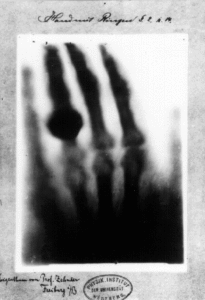Good morning, Whitewater.
Election Day in town will see an even chance of morning showers, with a high of fifty-six. Sunrise is 6:39 AM and sunset 4:37 PM, for 9h 58m 02s of daytime. The moon is a waxing gibbous with 56.8% of its visible disk illuminated.
On this day in 1895, Röntgen discovers X-rays:
Wilhelm Conrad Röntgen … 27 March 1845 – 10 February 1923) was a German mechanical engineer and physicist, who, on 8 November 1895, produced and detected electromagnetic radiation in a wavelength range known as X-rays or Röntgen rays, an achievement that earned him the first Nobel Prize in Physics in 1901.[2] In honour of his accomplishments, in 2004 the International Union of Pure and Applied Chemistry (IUPAC) named element 111, roentgenium, a radioactive element with multiple unstable isotopes, after him….
In the late afternoon of 8 November 1895, Röntgen was determined to test his idea. He carefully constructed a black cardboard covering similar to the one he had used on the Lenard tube. He covered the Hittorf-Crookes tube with the cardboard and attached electrodes to a Ruhmkorff coil to generate an electrostatic charge. Before setting up the barium platinocyanide screen to test his idea, Röntgen darkened the room to test the opacity of his cardboard cover. As he passed the Ruhmkorff coil charge through the tube, he determined that the cover was light-tight and turned to prepare the next step of the experiment. It was at this point that Röntgen noticed a faint shimmering from a bench a few feet away from the tube. To be sure, he tried several more discharges and saw the same shimmering each time. Striking a match, he discovered the shimmering had come from the location of the barium platinocyanide screen he had been intending to use next.
Röntgen speculated that a new kind of ray might be responsible. 8 November was a Friday, so he took advantage of the weekend to repeat his experiments and make his first notes. In the following weeks he ate and slept in his laboratory as he investigated many properties of the new rays he temporarily termed “X-rays”, using the mathematical designation (“X”) for something unknown. The new rays came to bear his name in many languages as “Röntgen Rays” (and the associated X-ray radiograms as “Röntgenograms”).
On this day in 1870, Increase Lapham goes national:
On this date Increase Lapham recorded the first published national weather forecast, calling for “high winds and falling temperatures for Chicago, Detroit and the Eastern cities.” [Source: History Just Ahead: A Guide to Wisconsin’s Historical Markers edited by Sarah Davis McBride]
Here’s JigZone‘s daily puzzle for Tuesday:

